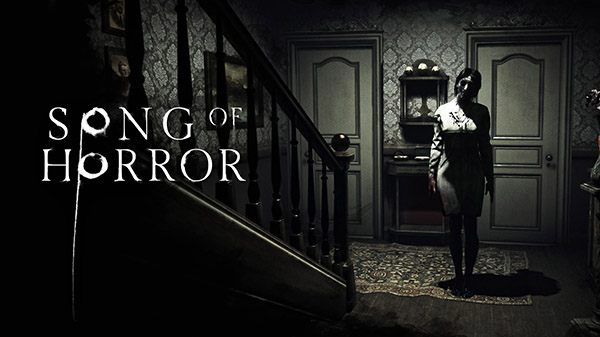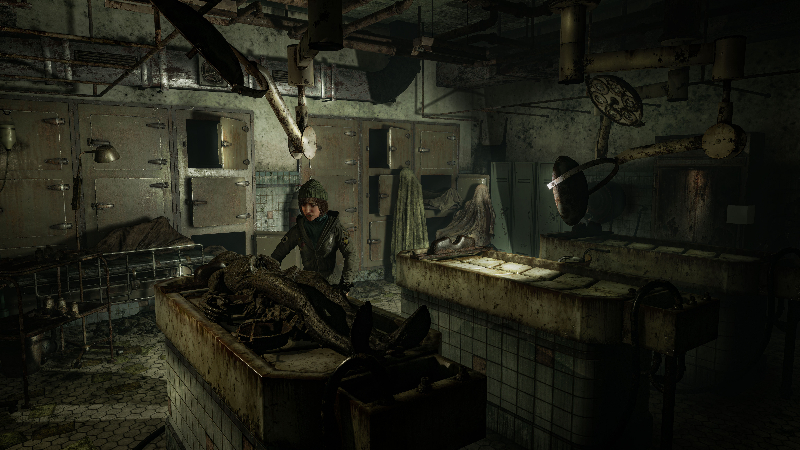As much as the indie game boom has been wonderful to experience over the last decade, horror games emerging from that space have been more lacking than one might expect. A run on a particular type of horror game has led to what are basically spooky adventure games, with faux threats and scripted scares. Song of Horror wonderfully bucks that trend.
This is a horror game built for fans of the original greats, like Silent Hill and Resident Evil, with great music and a strong atmosphere, all the way down to its rather obtuse puzzles.
Song of Horror Review: Ode to the Classics
Perhaps more than anything else, Song of Horror feels like a modern reimagining of those classics. While the fixed camera angles and environmental puzzles both feel plucked right out of 1999, Song of Horror stands out thanks to the team reconsidering how best to tell its particular story, making for a unique experience even if you’re one to play all the horror games that release.
In Song of Horror, players take on the role of up to 13 different characters in a story originally split into five episodes on PC. Now on consoles, the Complete Edition tells the whole tale in one package, but you’ll quickly learn it’s not the objective to see all 13 characters. Each episode features three of four playable characters, and players can start with anyone.
On all but one of the game’s four difficulties, permadeath is enabled and forever looms over each playthrough. Should any of your characters die at the hands of The Presence, a shape-shifting monster stalking anyone who comes in contact with the titular forbidden song, they’re gone for good. Left behind are their belongings like crucial quest items, and you can return to that spot as the next hopeful survivor to pick up where they left off.
An early haunted house locale in the first episode sets a stunning scene, with ambient noise designed to leave players uneasy and an adaptive threat that can be around virtually any corner. The Presence is partly unscripted, and in an unexpected way, operates sort of like the AI Director of Left 4 Dead. Staying in an area for too long or sprinting down every hallway can each trigger its appearance in different ways.
There’s no action combat. Instead, the game throws players into QTE-heavy mini-games each time a monster arrives on the scene. Sometimes this means dashing underneath a nearby table and slowing your heart rate before The Presence swallows you up. Other times it means wrestling over a door, desperate to keep the entity locked out on the other side. There are four or five different mini-games, and all but one of them are fairly effective.
While this approach is less exciting than proper third-person combat, it’s much preferred to the usual indie horror route of never actually threatening the player and instead just pretending to. Whereas most indie horrors seem to take the scripted scares route due to budget, Song of Horror finds a way to implement real threats. While rather novel for its genre, the added caution of permadeath means Song of Horror still feels more like a game out of another decade than anything else because the horror is genuine and largely unpredictable.
The story centers around Daniel Noyer in 1998, whose job working for a book publishing company brings him to the awesomely creepy home of a reclusive author whose follow-up to a bestseller is long-awaited. The story eventually takes players to a range of locations, each one filled with the sort of obtuse puzzles fans of the genre will associate most with the PS2 era.
Finding a fridge magnet and combining it with a coat hanger to pry a set of keys from behind a locked gate is the kind of puzzling that may very well need a guide from most players, and though I tend to feel dragged down by games that stump me to the point of recurring Google searches, I didn’t mind it with Song of Horror. Most of what else is here works really well, so much that I was excited to get to the end and see how it all played out.
Where it does frustrate, however, is with its routine use of unknowable death traps. In a good horror story, it’s probably true that some characters shouldn’t make it. The stakes feel higher if some characters have died, but in Song of Horror, the player couldn’t possibly see some of their characters’ death coming. With so many interactable objects around each level, some are set to kill players immediately should they touch them.
My first brush with this was with a standing mirror draped in a cloth and stuffed inside a closet. Removing the cloth led to a cutscene showing one of my characters dying instantly. There’s no way to know not to do that, and it’s not the only place where it happens. Deaths like this feel not just unfair but very annoying. If I fail a QTE, that’s on me. If I’m interacting with hundreds of objects in every level and a small handful of them might kill me, it’s not fun trying to figure out which ones those are.
Luckily, I only lost one character this way in the end, but only because I looked up what else to avoid. It feels like cheating, but so does the implementation of such death traps.
In every other important way, Song of Horror is the well-made blend of old- and new-school horror concepts it set out to be. The permadeath and multiple characters feel fresh, while the puzzles and presentation give it the endless charm of a genre classic. I found the AI-directed monster to be fair and unpredictable, and the story remains interesting all the way through to a very chilling final scene.
Perhaps my favorite thing about Song of Horror is simply its atmosphere. Especially in the first level, Song of Horror has the feel of a timeless ghost story. Each space feels lived in and labyrinthine in that familiar horror way. There are surprisingly few haunted house stories in games, despite being a constant landmark in other horror media. Honestly, Song of Horror didn’t need to be as good as it is to be memorable. It already stands out from the endless ocean of first-person, Lovecraftian on-rails horror adventures, but not satisfied with just being different, Song of Horror is also very good in any context.
Song of Horror Review — The Bottom Line
Pros
- Multiple playable characters and permadeath refresh its otherwise classic horror design
- Great atmosphere and music to set the tone
- A story well worth seeing through to the end
Cons
- Death traps galore
It wears its appreciation for its predecessors on its sleeve, with ample references to Silent Hill in things like collectibles found and achievement names, and it has some music akin to the safe room scores of past Resident Evil games. It all implies the team at Protocol Games is comprised of fans, and that really shines through in the rest of the game. This is survival-horror for players aching for more of the classics, with enough of a modern makeover to merit horror fans of all types give it a try.
Song of Horror was once set to launch last October in time for the Halloween season, a time which drives many players to invest more money and time into horror. Hopefully, releasing in the late spring doesn’t mean it goes unnoticed. This is a very good addition to the genre, which stands closer to the greats of generations past than the never-ending train of horror-lite adventure games.
By innovating on the games that so clearly inspired it, Song of Horror feels comfortably set in two worlds at once: past and present, and with any luck, it may inspire the future of horror games as well.
[Note: Protocol Games provided the copy of Song of Horror used for this review.]










Published: Jun 7, 2021 10:48 am